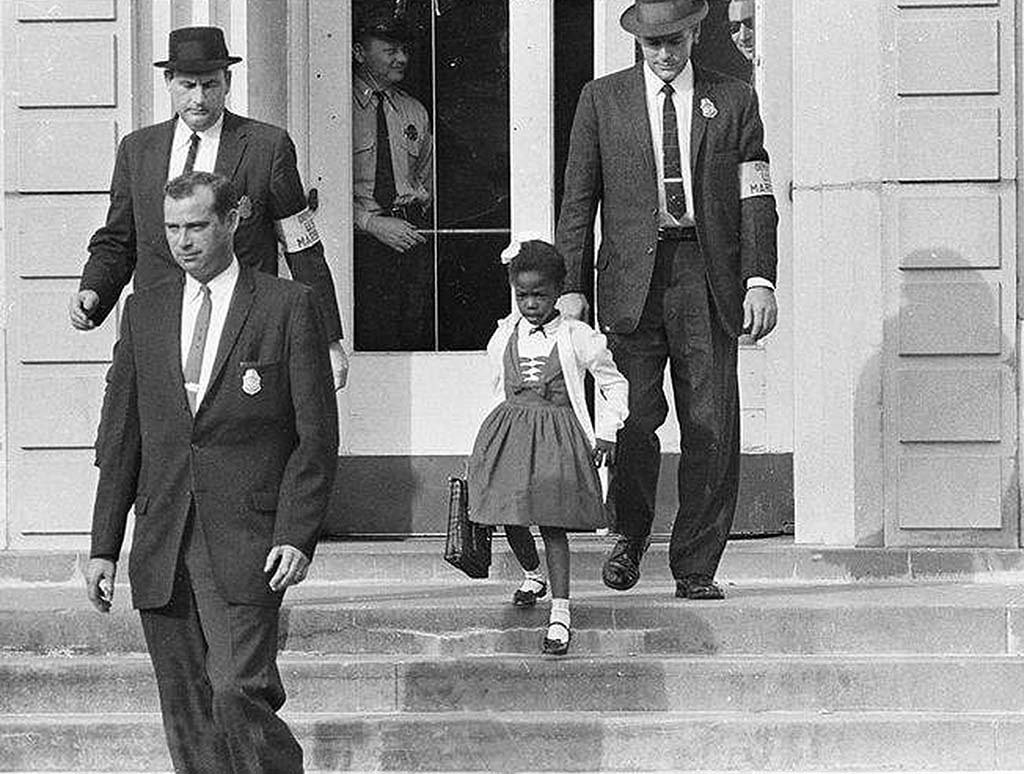Ruby Bridges became famous in 1960 as the six-year-old who, escorted by Federal marshals, integrated a formerly all-white school in New Orleans, Louisiana. Bridges was born on September 8, 1954 in Tylertown, Mississippi, to Lucille and Abon Bridges. She was the firstborn of eight children. Her parents worked as sharecroppers then when she was four they moved to New Orleans in 1958. One year later Ruby began kindergarten at Johnson Lockett Elementary, a segregated school.
Two years after the Brown v. Board of Education ruling that called for integration of public schools, Federal District Court Judge J. Skelly Wright ordered that the New Orleans School Board formulate an integration plan for public schools. After four years of opposition, the school board chose to integrate two formerly all-white schools in the fall of 1960. Both schools, William Frantz and McDonough 19, were located in New Orleans’s Ninth Ward. Bridges was one of a handful of African American children chosen to attend William Frantz Public School.
November 14, 1960 marked Ruby Bridges’ first day at William Frantz. Three other African American first graders, Leona Tate, Tessie Prevost, and Gaile Etienne, also began school that day at McDonough 19. Because of the threat of violence Ruby was escorted to school by four armed U.S. Federal marshals. When they were met by protestors and media, she spent her first day of school in the principal’s office. When she did begin classes, Bridges was the only student in her classroom as white families had withdrawn their children from the school. By December 5, 1960, only eighteen other students attended classes at William Frantz.
Ruby Bridges was taught by Barbara Henry, a white teacher new to the school. She was not allowed to go to recess or eat lunch in the cafeteria because it was deemed too dangerous. Her family also suffered from the decision to integrate; they were asked to avoid shopping in neighborhood stores and her father, Abon, was fired from his job. Sympathetic citizens across the country sent the Bridges money and gifts to help. Ruby Bridges also received a letter of support from former First Lady Eleanor Roosevelt.
Bridges spent the entire first grade year receiving one-on-one instruction from Barbara Henry. She was escorted to school by U.S. Marshals or driven by a taxi each day. By the beginning of second grade the protestors were gone and the classes were officially integrated.
Ruby Bridges’ story was immortalized in works of art. John Steinbeck wrote about Ruby and the other girls who integrated the New Orleans schools in his book Travels with Charley. Inspired by selections from the book, painter Norman Rockwell created his work “The Problem We All Live With,” which was published in the January 14, 1964 issue of Look magazine.
Bridges graduated from an integrated high school in New Orleans, and still resides in the city. She later became a travel agent and was one of the first African Americans to work for American Express in New Orleans. She also married Malcolm Hall and had four sons. Ironically Bridges worked as a parent liaison at William Frantz School, which now has an African American majority like most inner-city New Orleans schools. She also established the Ruby Bridges Foundation.

